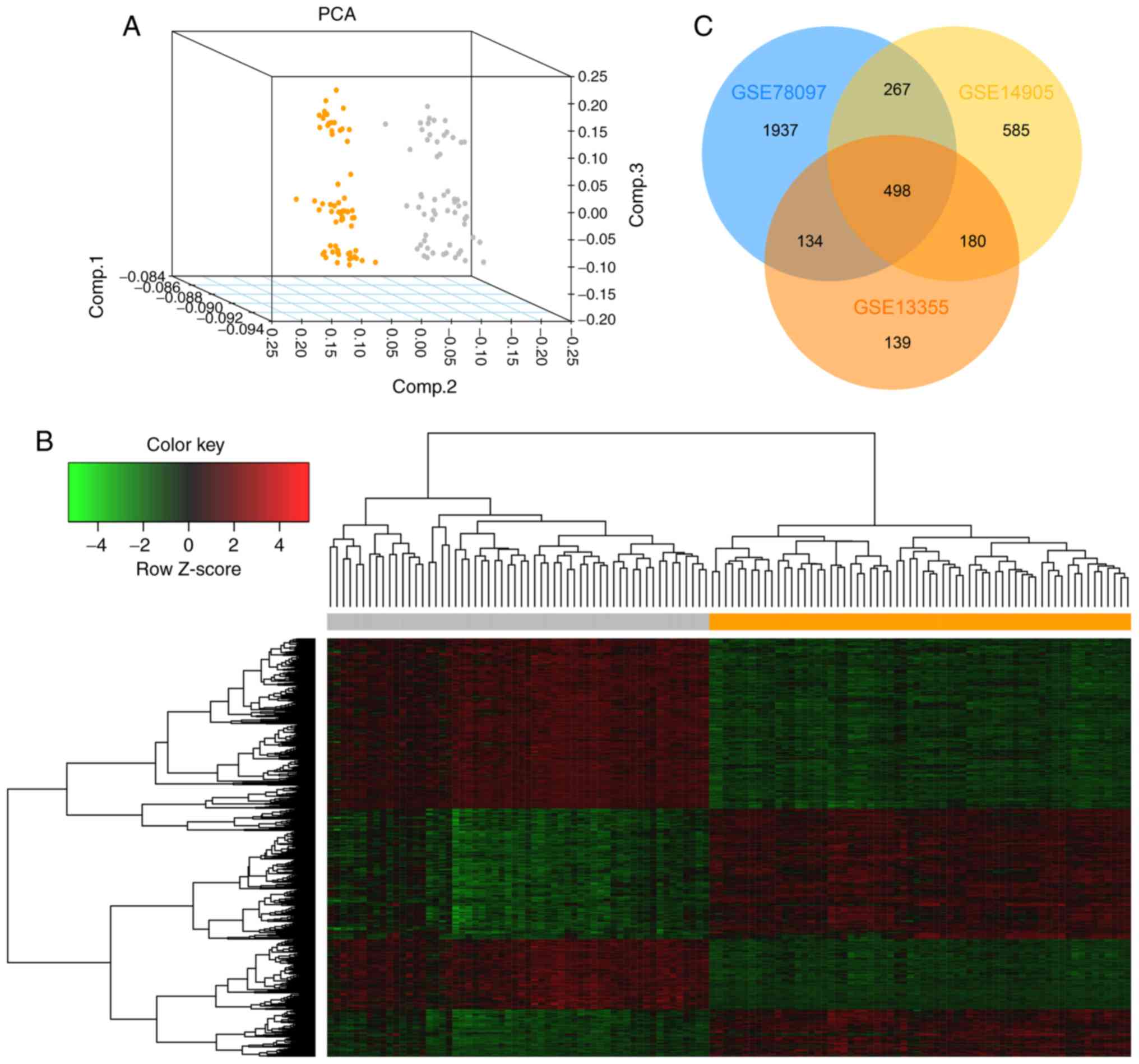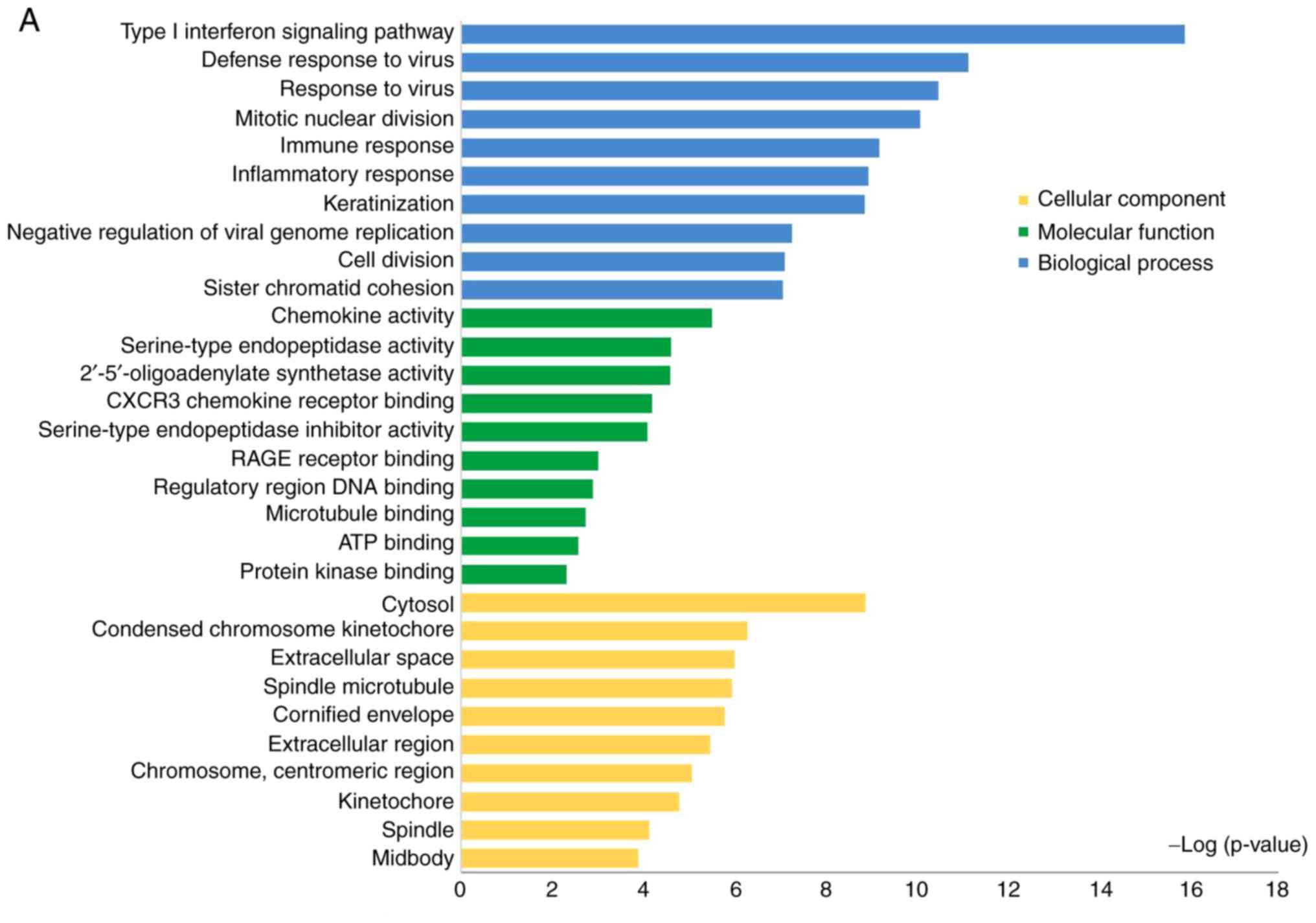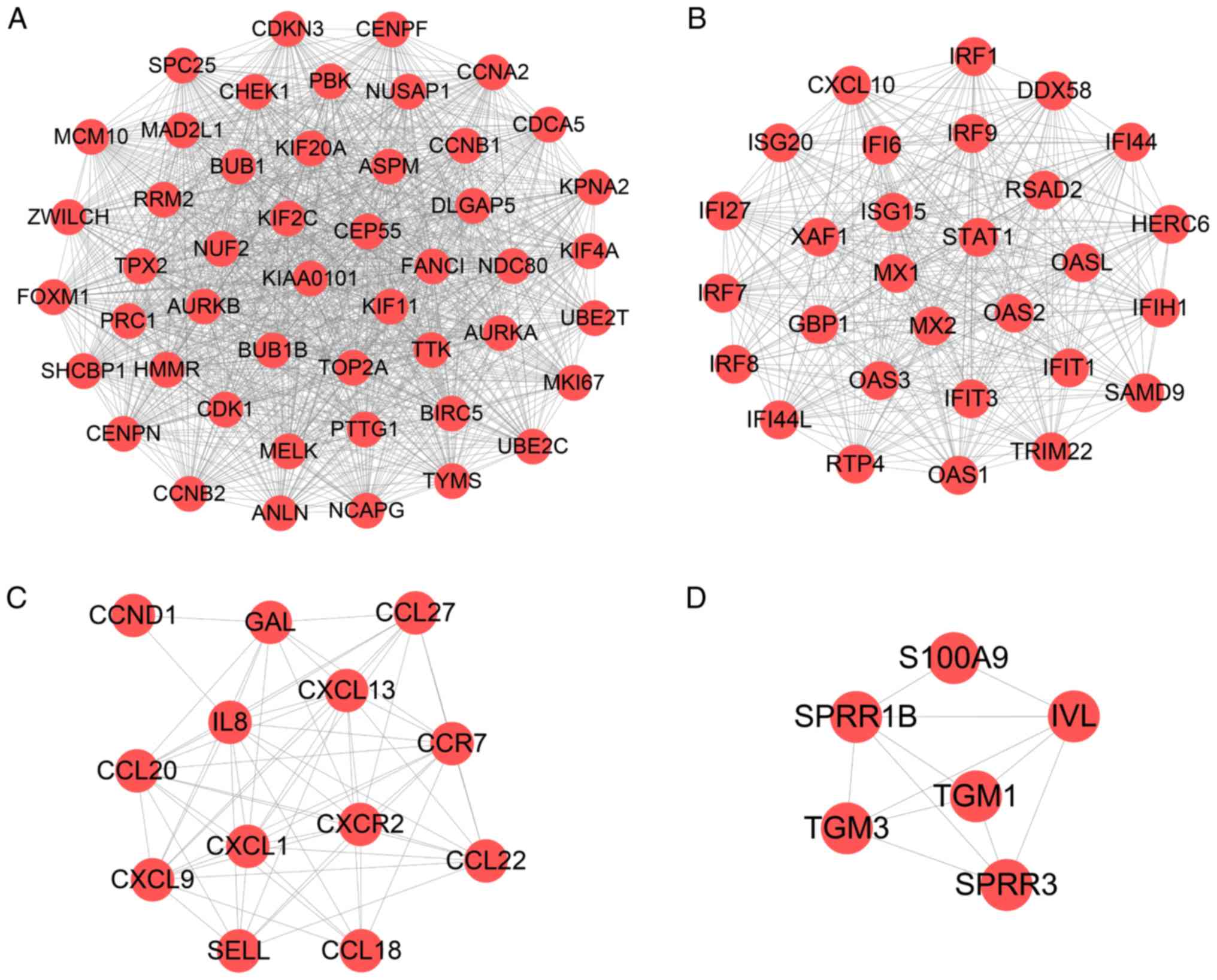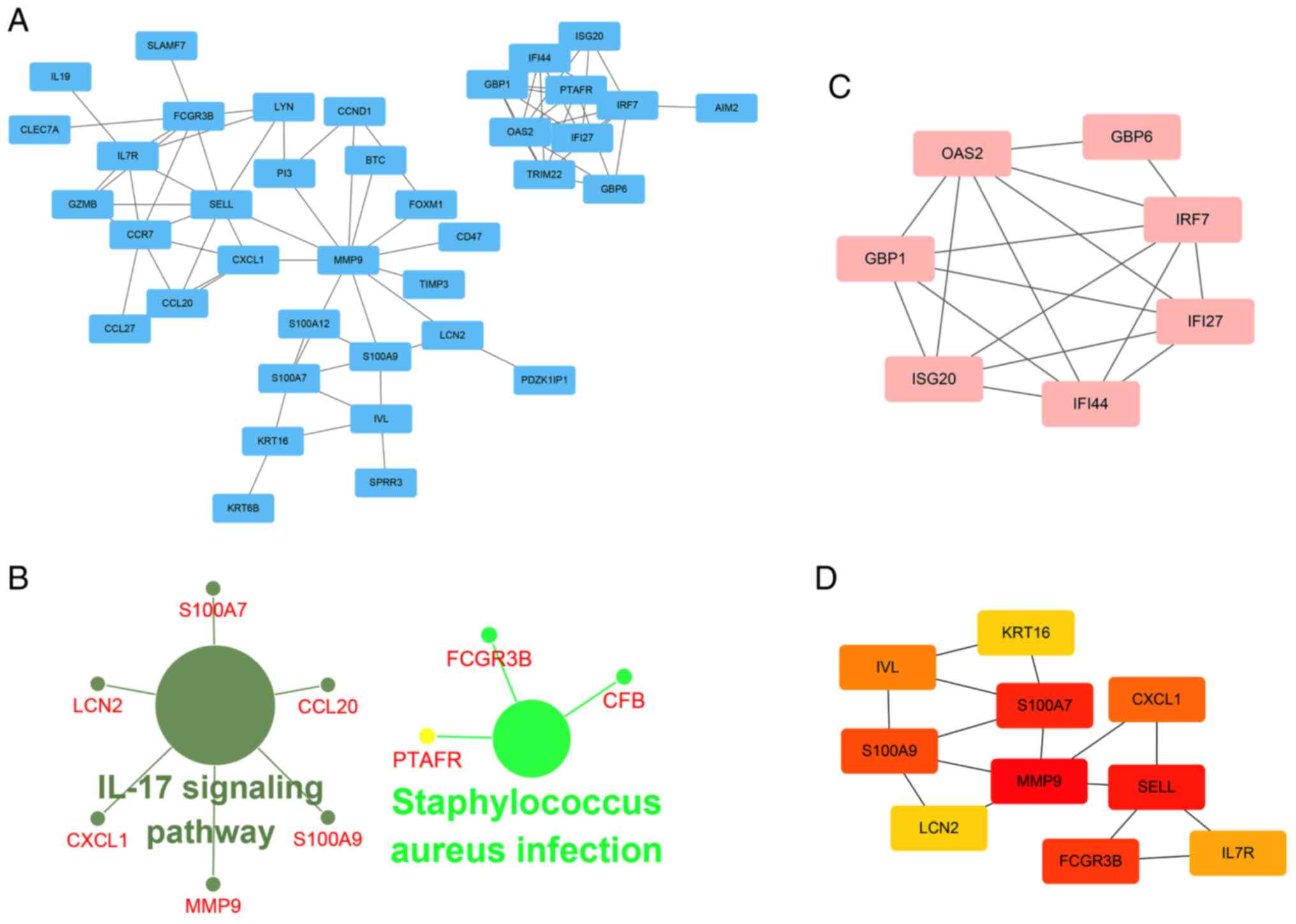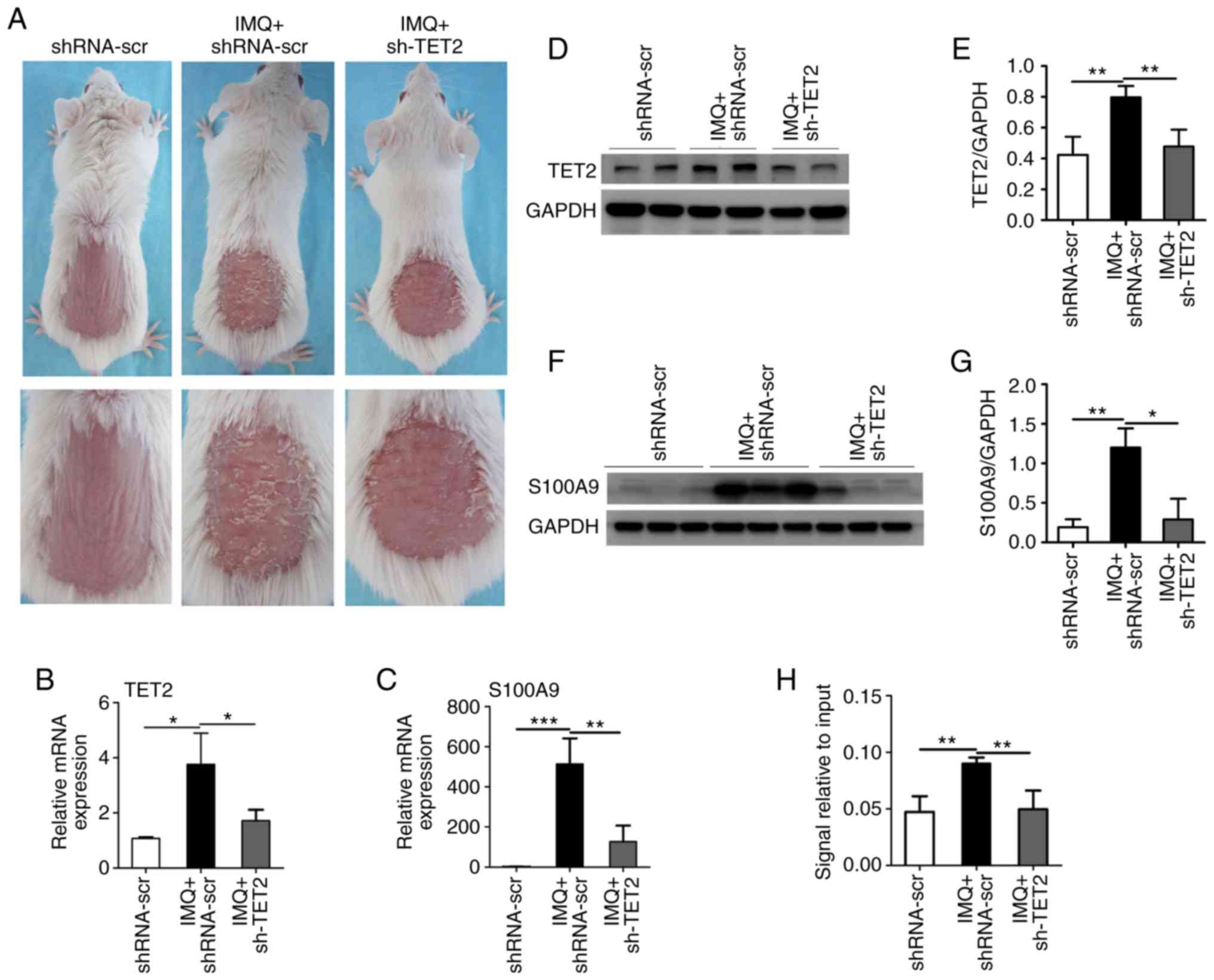|
1
|
Raychaudhuri SK, Maverakis E and
Raychaudhuri SP: Diagnosis and classification of psoriasis.
Autoimmun Rev. 13:490–495. 2014. View Article : Google Scholar : PubMed/NCBI
|
|
2
|
Duffin KC, Chandran V, Gladman DD, Krueger
GG, Elder JT and Rahman P: Genetics of psoriasis and psoriatic
arthritis: Update and future direction. J Rheumatol. 35:1449–1453.
2008.PubMed/NCBI
|
|
3
|
Fogel O, Richard-Miceli C and Tost J:
Epigenetic changes in chronic inflammatory diseases. Adv Protein
Chem Struct Biol. 106:139–189. 2017. View Article : Google Scholar : PubMed/NCBI
|
|
4
|
Griffiths CE: The immunological basis of
psoriasis. J Eur Acad Dermatol Venereol. 17(Suppl 2): S1–S5. 2003.
View Article : Google Scholar
|
|
5
|
Boehncke WH and Schön MP: Psoriasis.
Lancet. 386:983–994. 2015. View Article : Google Scholar : PubMed/NCBI
|
|
6
|
Turek-Plewa J and Jagodziński PP: The role
of mammalian DNA methyltransferases in the regulation of gene
expression. Cell Mol Biol Lett. 10:631–647. 2005.PubMed/NCBI
|
|
7
|
Ichiyama K, Chen T, Wang X, Yan X, Kim BS,
Tanaka S, Ndiaye-Lobry D, Deng Y, Zou Y, Zheng P, et al: The
methyl-cytosine dioxygenase Tet2 promotes DNA demethylation and
activation of cytokine gene expression in T cells. Immunity.
42:613–626. 2015. View Article : Google Scholar : PubMed/NCBI
|
|
8
|
Solary E, Bernard OA, Tefferi A, Fuks F
and Vainchenker W: The ten-eleven translocation-2 (TET2) gene in
hematopoiesis and hematopoietic diseases. Leukemia. 28:485–496.
2014. View Article : Google Scholar
|
|
9
|
Wang X, Liu X, Duan X, Zhu K, Zhang S, Gan
L, Liu N, Jaypaul H, Makamure JT, Ming Z and Chen H: Ten-eleven
translocation-2 regulates DNA hydroxymethylation status and
psoriasiform dermatitis progression in mice. Acta Derm Venereol.
98:585–593. 2018. View Article : Google Scholar : PubMed/NCBI
|
|
10
|
Roberson ED, Liu Y, Ryan C, Joyce CE, Duan
S, Cao L, Martin A, Liao W, Menter A and Bowcock AM: A subset of
methylated CpG sites differentiate psoriatic from normal skin. J
Invest Dermatol. 132:583–592. 2012. View Article : Google Scholar
|
|
11
|
Chen L, Sun F, Yang X, Jin Y, Shi M, Wang
L, Shi Y, Zhan C and Wang Q: Correlation between RNA-Seq and
microarrays results using TCGA data. Gene. 628:200–204. 2017.
View Article : Google Scholar : PubMed/NCBI
|
|
12
|
Li B, Tsoi LC, Swindell WR, Gudjonsson JE,
Tejasvi T, Johnston A, Ding J, Stuart PE, Xing X, Kochkodan JJ, et
al: Transcriptome analysis of psoriasis in a large case-control
sample: RNA-seq provides insights into disease mechanisms. J Invest
Dermatol. 134:1828–1838. 2014. View Article : Google Scholar : PubMed/NCBI
|
|
13
|
Liu J, Li H, Sun L, Wang Z, Xing C and
Yuan Y: Aberrantly methylated-differentially expressed genes and
pathways in colorectal cancer. Cancer Cell Int. 17:752017.
View Article : Google Scholar : PubMed/NCBI
|
|
14
|
Huo X, Sun H, Cao D, Yang J, Peng P, Yu M
and Shen K: Identification of prognosis markers for endometrial
cancer by integrated analysis of DNA methylation and RNA-Seq data.
Sci Rep. 9:99242019. View Article : Google Scholar : PubMed/NCBI
|
|
15
|
Gautier L, Cope L, Bolstad BM and Irizarry
RA: Affy-analysis of affymetrix GeneChip data at the probe level.
Bioinformatics. 20:307–315. 2004. View Article : Google Scholar : PubMed/NCBI
|
|
16
|
Ritchie ME, Phipson B, Wu D, Hu Y, Law CW,
Shi W and Smyth GK: Limma powers differential expression analyses
for RNA-sequencing and microarray studies. Nucleic Acids Res.
43:e472015. View Article : Google Scholar : PubMed/NCBI
|
|
17
|
Dennis G Jr, Sherman BT, Hosack DA, Yang
J, Gao W, Lane HC and Lempicki RA: DAVID: Database for annotation,
visualization, and integrated discovery. Genome Biol. 4:P32003.
View Article : Google Scholar : PubMed/NCBI
|
|
18
|
Ashburner M, Ball CA, Blake JA, Botstein
D, Butler H, Cherry JM, Davis AP, Dolinski K, Dwight SS, Eppig JT,
et al: Gene ontology: Tool for the unification of biology. The gene
ontology consortium Nat Genet. 25:25–29. 2000.
|
|
19
|
Szklarczyk D, Franceschini A, Kuhn M,
Simonovic M, Roth A, Minguez P, Doerks T, Stark M, Muller J, Bork
P, et al: The STRING database in 2011: Functional interaction
networks of proteins, globally integrated and scored. Nucleic Acids
Res. 39:D561–D568. 2011. View Article : Google Scholar :
|
|
20
|
Chin CH, Chen SH, Wu HH, Ho CW, Ko MT and
Lin CY: cyto-Hubba: Identifying hub objects and sub-networks from
complex interactome. BMC Syst Biol. 8(Suppl 4): S112014. View Article : Google Scholar
|
|
21
|
van der Fits L, Mourits S, Voerman JS,
Kant M, Boon L, Laman JD, Cornelissen F, Mus AM, Florencia E, Prens
EP and Lubberts E: Imiquimod-induced psoriasis-like skin
inflammation in mice is mediated via the IL-23/IL-17 axis. J
Immunol. 182:5836–5845. 2009. View Article : Google Scholar : PubMed/NCBI
|
|
22
|
Schukur L, Geering B, Charpin-El Hamri G
and Fussenegger M: Implantable synthetic cytokine converter cells
with AND-gate logic treat experimental psoriasis. Sci Transl Med.
7:318ra2012015. View Article : Google Scholar : PubMed/NCBI
|
|
23
|
Taves S, Berta T, Liu DL, Gan S, Chen G,
Kim YH, Van de Ven T, Laufer S and Ji RR: Spinal inhibition of p38
MAP kinase reduces inflammatory and neuropathic pain in male but
not female mice: Sex-dependent microglial signaling in the spinal
cord. Brain Behav Immun. 55:70–81. 2016. View Article : Google Scholar
|
|
24
|
Gargiulo S, Greco A, Gramanzini M,
Esposito S, Affuso A, Brunetti A and Vesce G: Mice anesthesia,
analgesia, and care, part I: Anesthetic considerations in
preclinical research. ILAR J. 53:E55–E69. 2012. View Article : Google Scholar
|
|
25
|
Livak KJ and Schmittgen TD: Analysis of
relative gene expression data using real-time quantitative PCR and
the 2(-Delta Delta C(T)) method. Methods. 25:402–408. 2001.
View Article : Google Scholar
|
|
26
|
Dong B, Wang G, Yao J, Yuan P, Kang W, Zhi
L and He X: Predicting novel genes and pathways associated with
osteosar-coma by using bioinformatics analysis. Gene. 628:32–37.
2017. View Article : Google Scholar : PubMed/NCBI
|
|
27
|
Mabuchi T and Hwang ST: ACKR2: Nature's
decoy receptor lures unsuspecting chemokines in psoriasis. J Invest
Dermatol. 137:7–11. 2017. View Article : Google Scholar
|
|
28
|
Reich K: The concept of psoriasis as a
systemic inflammation: Implications for disease management. J Eur
Acad Dermatol Venereol. 26(Suppl 2): S3–S11. 2012. View Article : Google Scholar
|
|
29
|
Zhu H, Lou F, Yin Q, Gao Y, Sun Y, Bai J,
Xu Z, Liu Z, Cai W, Ke F, et al: RIG-I antiviral signaling drives
interleukin-23 production and psoriasis-like skin disease. EMBO Mol
Med. 9:589–604. 2017. View Article : Google Scholar : PubMed/NCBI
|
|
30
|
Colombo M, Raposo G and Théry C:
Biogenesis, secretion, and intercellular interactions of exosomes
and other extracellular vesicles. Annu Rev Cell Dev Biol.
30:255–289. 2014. View Article : Google Scholar : PubMed/NCBI
|
|
31
|
Pelletier F, Garnache-Ottou F, Angelot F,
Biichlé S, Vidal C, Humbert P, Saas P, Seillès E and Aubin F:
Increased levels of circulating endothelial-derived microparticles
and small-size platelet-derived microparticles in psoriasis. J
Invest Dermatol. 131:1573–1576. 2011. View Article : Google Scholar : PubMed/NCBI
|
|
32
|
Pelletier F, Garnache-Ottou F, Biichlé S,
Vivot A, Humbert P, Saas P, Seillès E and Aubin F: Effects of
anti-TNF-α agents on circulating endothelial-derived and
platelet-derived micropar-ticles in psoriasis. Exp Dermatol.
23:924–925. 2014. View Article : Google Scholar : PubMed/NCBI
|
|
33
|
Li J, Chen C, Bi X, Zhou C, Huang T, Ni C,
Yang P, Chen S, Ye M and Duan S: DNA methylation of CMTM3, SSTR2,
and MDFI genes in colorectal cancer. Gene. 630:1–7. 2017.
View Article : Google Scholar : PubMed/NCBI
|
|
34
|
Lowes MA, Russell CB, Martin DA, Towne JE
and Krueger JG: The IL-23/T17 pathogenic axis in psoriasis is
amplified by keratinocyte responses. Trends Immunol. 34:174–181.
2013. View Article : Google Scholar : PubMed/NCBI
|
|
35
|
Donato R, Cannon BR, Sorci G, Riuzzi F,
Hsu K, Weber DJ and Geczy CL: Functions of S100 proteins. Curr Mol
Med. 13:24–57. 2013. View Article : Google Scholar :
|
|
36
|
Madsen P, Rasmussen HH, Leffers H, Honoré
B, Dejgaard K, Olsen E, Kiil J, Walbum E, Andersen AH, Basse B, et
al: Molecular cloning, occurrence, and expression of a novel
partially secreted protein 'psoriasin' that is highly up-regulated
in psoriatic skin. J Invest Dermatol. 97:701–712. 1991. View Article : Google Scholar : PubMed/NCBI
|
|
37
|
Gschwandtner M, Zhong S, Tschachler A,
Mlitz V, Karner S, Elbe-Bürger A and Mildner M: Fetal human
keratinocytes produce large amounts of antimicrobial peptides:
Involvement of histone-methylation processes. J Invest Dermatol.
134:2192–2201. 2014. View Article : Google Scholar : PubMed/NCBI
|
|
38
|
Monhian N, Jewett BS, Baker SR and Varani
J: Matrix metal-loproteinase expression in normal skin associated
with basal cell carcinoma and in distal skin from the same
patients. Arch Facial Plast Surg. 7:238–243. 2005. View Article : Google Scholar : PubMed/NCBI
|
|
39
|
Głażewska EK, Niczyporuk M, Ławicki S,
Szmitkowski M, Donejko M, Zajkowska M, Będkowska GE and Przylipiak
A: Narrowband ultraviolet B light treatment changes plasma
concentrations of MMP-3, MMP-9 and TIMP-3 in psoriatic patients.
Ther Clin Risk Manag. 13:575–582. 2017. View Article : Google Scholar :
|
|
40
|
Chicoine E, Estève PO, Robledo O, Van
Themsche C, Potworowski EF and St-Pierre Y: Evidence for the role
of promoter methylation in the regulation of MMP-9 gene expression.
Biochem Biophys Res Commun. 297:765–772. 2002. View Article : Google Scholar : PubMed/NCBI
|
|
41
|
Wu Y, Zhang Z, Tao L, Chen G, Liu F, Wang
T, Xue F, Chen Y, He L, Zheng J and Liu Y: A high copy number of
FCGR3B is associated with psoriasis vulgaris in Han Chinese.
Dermatology. 229:70–75. 2014. View Article : Google Scholar : PubMed/NCBI
|
|
42
|
Lee SK, Jeon EK, Kim YJ, Seo SH, Kim CD,
Lim JS and Lee JH: A global gene expression analysis of the
peripheral blood mono-nuclear cells reveals the gene expression
signature in psoriasis. Ann Dermatol. 21:237–242. 2009. View Article : Google Scholar
|
|
43
|
Raposo RA, Gupta R, Abdel-Mohsen M, Dimon
M, Debbaneh M, Jiang W, York VA, Leadabrand KS, Brown G, Malakouti
M, et al: Antiviral gene expression in psoriasis. J Eur Acad
Dermatol Venereol. 29:1951–1957. 2015. View Article : Google Scholar : PubMed/NCBI
|
|
44
|
Rittié L and Elder JT: Capturing the finer
points of gene expression in psoriasis: Beaming in on the
CCL19/CCR7 axis. J Invest Dermatol. 132:1535–1538. 2012. View Article : Google Scholar : PubMed/NCBI
|
|
45
|
Shao S, Cao T, Jin L, Li B, Fang H, Zhang
J, Zhang Y, Hu J and Wang G: Increased lipocalin-2 contributes to
the pathogenesis of psoriasis by modulating neutrophil chemotaxis
and cytokine secretion. J Invest Dermatol. 136:1418–1428. 2016.
View Article : Google Scholar : PubMed/NCBI
|
|
46
|
Honda K, Yanai H, Negishi H, Asagiri M,
Sato M, Mizutani T, Shimada N, Ohba Y, Takaoka A, Yoshida N and
Taniguchi T: IRF-7 is the master regulator of type-I
interferon-dependent immune responses. Nature. 434:772–777. 2005.
View Article : Google Scholar : PubMed/NCBI
|
|
47
|
Ma S, Wan X, Deng Z, Shi L, Hao C, Zhou Z,
Zhou C, Fang Y, Liu J, Yang J, et al: Epigenetic regulator CXXC5
recruits DNA demethylase Tet2 to regulate TLR7/9-elicited IFN
response in pDCs. J Exp Med. 214:1471–1491. 2017. View Article : Google Scholar : PubMed/NCBI
|
|
48
|
Ehrchen JM, Sunderkötter C, Foell D, Vogl
T and Roth J: The endogenous Toll-like receptor 4 agonist
S100A8/S100A9 (calprotectin) as innate amplifier of infection,
autoimmunity, and cancer. J Leukoc Biol. 86:557–566. 2009.
View Article : Google Scholar : PubMed/NCBI
|
|
49
|
Sevimoglu T and Arga KY: Computational
systems biology of psoriasis: Are we ready for the age of Omics and
systems biomarkers? OMICS. 19:669–687. 2015. View Article : Google Scholar : PubMed/NCBI
|
|
50
|
Guo P, Luo Y, Mai G, Zhang M, Wang G, Zhao
M, Gao L, Li F and Zhou F: Gene expression profile based
classification models of psoriasis. Genomics. 103:48–55. 2014.
View Article : Google Scholar
|















